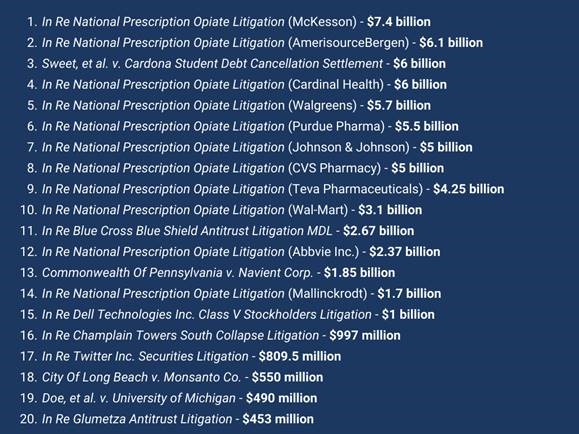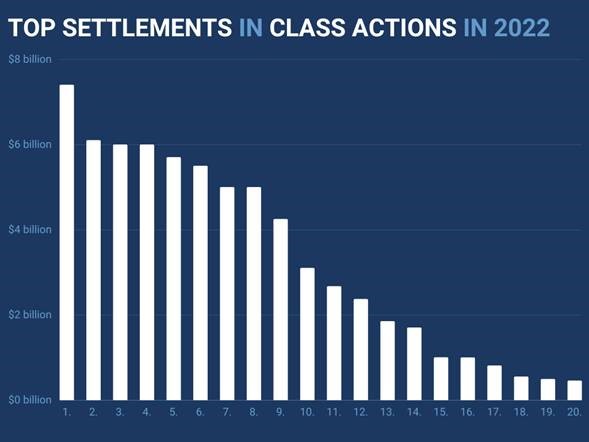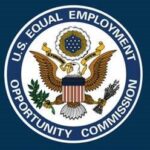 By Gerald L. Maatman, Jr. and Jennifer A. Riley
By Gerald L. Maatman, Jr. and Jennifer A. Riley
Duane Morris Takeaways: As we kick off 2023, this is the inaugural year of the new Duane Morris Class Action Review. It is a one-of-its-kind publication analyzing class action trends, decisions, and settlements in all areas impacting Corporate America, including the substantive areas of antitrust, appeals, the Class Action Fairness Act, civil rights, consumer fraud, data breach, EEOC-Initiated and government enforcement litigation, employment discrimination, the Employee Retirement Income Security Act of 1974, the Fair Credit Reporting Act, wage & hour class and collective actions, labor, privacy, procedural issues, product liability and mass torts, the Racketeer Influenced and Corrupt Organizations Act, securities fraud, state court class actions, the Telephone Consumer Protection Act, and the Worker Adjustment and Retraining Notification Act. The Review also highlights key rulings on attorneys’ fee awards in class actions, motions granting and denying sanctions in class actions, and the top class action settlement in each area. Finally, the Review provides insight as to what companies and corporate counsel can expect to see in 2023.
Click here to access our customized website featuring all the Review highlights, including the ten major trends across all types of class actions over the past year.
Order your copy of the eBook here, and download the Review overview on the key Rule 23 decisions and top class action settlements here.
The 2023 Review analyzes rulings from all state and federal courts in 23 areas of law. It is designed as a reader-friendly research tool that is easily accessible in hard copy and e-Book formats. Class action rulings from throughout the year are analyzed and organized into 23 chapters and 4 appendices for ease of analysis and reference.
Executive Summary Of Key Class Action Trends Over The Past Year
Class action litigation presents one of the most significant risks to corporate defendants today. Procedural mechanisms like the one set forth in Rule 23 of the Federal Rules of Civil Procedure have the potential to expand a claim asserted on behalf of a single person into a claim asserted on behalf of a behemoth that includes every employee, customer, or user of a particular company, product, or service, over an extended period. With the potential for exponential enlargement of the size and scope of an action comes the potential for exponential expansion of peril for a corporate defendant. Class action lawsuits can create legal nightmares for companies and their management teams. The exposure created by such aggregation of claims can pose a challenge to a corporation’s balance sheet, market share, and reputation. Sometimes such litigation can push a defendant into bankruptcy.
With the growth of class action litigation over the past decade, counsel for defendants and plaintiffs alike have become more sophisticated, the statutory authority and case law precedents have continued to evolve, and parties on both sides have expanded their arsenal of tools to pursue and to defend these cases. As a result, class action litigation entails ever-changing guideposts, new playbooks, and innovation. The plaintiffs’ class action bar used Rule 23 to its fullest in 2022 in prosecuting class actions against Corporate America. The result was a year like no other in the class action space.
defendants and plaintiffs alike have become more sophisticated, the statutory authority and case law precedents have continued to evolve, and parties on both sides have expanded their arsenal of tools to pursue and to defend these cases. As a result, class action litigation entails ever-changing guideposts, new playbooks, and innovation. The plaintiffs’ class action bar used Rule 23 to its fullest in 2022 in prosecuting class actions against Corporate America. The result was a year like no other in the class action space.
We identified 10 key trends that characterize the past year. These trends involve: (i) massive class action settlements; (ii) U.S. Supreme Court decisional law on class action issues; (iii) set-backs and statutory impediments to the arbitration defense; (iv) plaintiff-friendly class certification conversion rates; (v) a simmering in government enforcement actions paired with indications of more aggressive federal and state agency litigation against corporations in the coming year; (vi) expansive growth in privacy class action litigation; (vii) an expansion of data protection issues that continue to plague corporate defendants; (viii) continued confusion over the problem of uninjured class members to class certification; (ix) aggressive assertion of defenses based on personal jurisdiction and venue; and (x) transformative rulings on the PAGA front including the first major setback for the plaintiffs’ bar.
Trend #1 – Class Action Settlements In 2022 Redistributed Wealth At An Unprecedented Level
Aside from the Big Tobacco settlements nearly two decades ago, 2022 marked the most extensive set of billion-dollar class action settlements in the history of the American court system. Many of these settlements arose from opioid litigation against manufactures, distributors, and retailers in the  pharmaceutical industry. On an aggregate basis, class actions and government enforcement lawsuits garnered more than $71 billion in settlements, with 15 class action cases settling for more than $1 billion. These settlements have redistributed wealth at an unprecedented rate. Suffice to say, 2022 was unlike any other year on the class action settlement front. As success often begets copy-cats, corporations can expect the plaintiffs’ class action bar will be equally if not more aggressive in their case filings and settlement positions in 2023.
pharmaceutical industry. On an aggregate basis, class actions and government enforcement lawsuits garnered more than $71 billion in settlements, with 15 class action cases settling for more than $1 billion. These settlements have redistributed wealth at an unprecedented rate. Suffice to say, 2022 was unlike any other year on the class action settlement front. As success often begets copy-cats, corporations can expect the plaintiffs’ class action bar will be equally if not more aggressive in their case filings and settlement positions in 2023.
Trend # 2 – The U.S. Supreme Court’s Decisions In 2022 Continued To Define The Class Action Landscape
As the ultimate referee of law, the U.S. Supreme Court has continued to define and shift the playing field for class action litigation. The Supreme Court’s rulings in 2022 were no exception. Consistent with its approach over the past several years, the Supreme Court issued three key rulings that impact the plaintiffs’ bar’s ability to bring and maintain class actions. The rulings include Southwest Airlines Co. v. Saxon, et al., 142 S.Ct. 1783 (2022), Morgan, et al. v. Sundance, Inc., 142 S.Ct. 1708 (2022), and Viking River Cruises, Inc. v. Moriana, et al., 142 S.Ct. 1906 (2022). The most effective tool for combating class actions may be the arbitration defense. Contrary to the tendency of its rulings in recent years to expand the arbitration defense, and thus make it more difficult for the plaintiffs’ bar to pursue claims on a class-wide basis, this past year the U.S. Supreme Court pulled back on the arbitration defense by narrowing its coverage.
Southwest Airlines Co. v. Saxon, et al., 142 S.Ct. 1783 (2022), Morgan, et al. v. Sundance, Inc., 142 S.Ct. 1708 (2022), and Viking River Cruises, Inc. v. Moriana, et al., 142 S.Ct. 1906 (2022). The most effective tool for combating class actions may be the arbitration defense. Contrary to the tendency of its rulings in recent years to expand the arbitration defense, and thus make it more difficult for the plaintiffs’ bar to pursue claims on a class-wide basis, this past year the U.S. Supreme Court pulled back on the arbitration defense by narrowing its coverage.
Trend # 3 – The Arbitration Defense Suffered Setbacks In 2022
Of all defenses, a defendant’s ability to enforce an arbitration agreement containing a class or collective action waiver may have had the single greatest impact in terms of shifting the pendulum of class action litigation. With its decision in Epic Systems Corp. v. Lewis, et al., 138 S. Ct. 1612 (2018), the U.S. Supreme Court cleared the last hurdle to widespread adoption of such agreements. In response, more companies of all types and sizes updated their onboarding materials, terms of use, and other types of agreements to require that any disputes be resolved in arbitration on an individual basis. To date, companies have enjoyed a high rate of success enforcing those agreements and using them to thwart class actions out of the gate. Given the impact of the arbitration defense, in 2023, companies may face additional hurdles, on the judicial or the legislative front, as the plaintiffs’ bar continues to look for workarounds.
Trend # 4 – The Likelihood Of Class Certification In 2022 Was As Strong As Ever
In 2022, the plaintiffs’ class action bar succeeded in certifying class actions at a high rate. Across all major types of class actions, courts issued rulings on over 360 motions to grant or to deny class certification in 2022. Of these, plaintiffs succeed in obtaining or maintaining certification in 268 rulings, with an overall success rate of nearly 75%. The plaintiffs’ class action bar obtained the highest rates of success in securities fraud, ERISA, WARN, and FLSA actions. In cases alleging securities fraud, plaintiffs succeeded in obtaining orders certifying classes in 23 of the 24 rulings issues during 2022, a success rate of 96%. In ERISA litigation, plaintiffs succeeded in obtaining orders certifying class in 18 of 23 rulings issued during 2022, a success rate of 78%. In cases alleging WARN violations, plaintiffs managed to certify classes in 100% of the suits that resulted in decisions this year.
Trend # 5 – Government Enforcement In 2022 Took A Back Seat
Over the past year, the Biden Administration continued to roll out changes on several fronts as it aimed to expand the rights, remedies, and procedural avenues available to workers. During 2022, such efforts fueled litigation. With its decision in West Virginia v. Environmental Protection Agency, 142 S.Ct. 2587 (2022), the U.S. Supreme Court imposed another hurdle to agency rule- making. Meanwhile, government enforcement litigation activity took a back seat. Over the past two years, the U.S. Department of Labor, in particular, has continued to roll out worker-friendly rules that could have a cascading impact on workplace class actions, including rules designed to wipe out the pro-business policies of the Trump Administration. Such efforts continued on multiple fronts in 2022, including with respect to rules regarding businesses’ utilization of independent contractors and their use of the tip credit. Whereas companies continued to see pro-business rules promulgated by the Trump Administration withdrawn and overwritten in 2022, courts continued to impose hurdles to agency rulemaking, the success of which will continue to be seen in 2023. Enforcement activity remained steady as political appointments remain pending. Employers are apt to see increased activity in 2023 as the EEOC in particular gains its full component of Biden appointees and can exercise its majority power to advance its agenda.
making. Meanwhile, government enforcement litigation activity took a back seat. Over the past two years, the U.S. Department of Labor, in particular, has continued to roll out worker-friendly rules that could have a cascading impact on workplace class actions, including rules designed to wipe out the pro-business policies of the Trump Administration. Such efforts continued on multiple fronts in 2022, including with respect to rules regarding businesses’ utilization of independent contractors and their use of the tip credit. Whereas companies continued to see pro-business rules promulgated by the Trump Administration withdrawn and overwritten in 2022, courts continued to impose hurdles to agency rulemaking, the success of which will continue to be seen in 2023. Enforcement activity remained steady as political appointments remain pending. Employers are apt to see increased activity in 2023 as the EEOC in particular gains its full component of Biden appointees and can exercise its majority power to advance its agenda.
Trend # 6 – Privacy Class Actions Became An Intense Focus Of The Plaintiffs’ Class Action Bar
Privacy litigation – in a multitude of forms and theories – manifested itself as the hottest area of growth in terms of activity by the plaintiffs’ class action bar. The Illinois Supreme Court likely will rule on key BIPA matters in the early part of 2023 and that the statute will continue to drive class action litigation. Its technical requirements, combined with stiff statutory penalties and fee-shifting, provide a recipe for attention from the plaintiff’s class action bar, and companies’ continued development and use of innovative technologies are apt to provide a veritable barrel of opportunity. The plaintiffs’ bar also grounded privacy claims in the electronic interception provisions of various state laws. While Congress has refrained from addressing data privacy through federal legislation, many states have enacted their own laws, and 2022 saw significant state legislative activity regarding data privacy with five states preparing for new privacy laws to take effect in 2023, including California, Colorado, Connecticut, Utah, and Virginia.
Trend # 7 – Data Protection Issues Continued To Plague Corporate Defendants
Companies that fall victim to data breach attacks have to contend not only with the significant costs of responding to the data breach and potential of government fines, but also the high costs of dealing with high-stakes class action lawsuits. Corporations also suffered setbacks as courts disagreed over the application of the U.S. Supreme Court’s decision in TransUnion v. Ramirez, et al., 141 S. Ct. 2190 (2021), to data breach cases. In TransUnion, the Supreme Court ruled that certain putative class members, who did not have their credit reports shared with third parties, did not suffer concrete harm and, therefore, lacked standing to sue. The Supreme Court decision in Ramirez has not resulted in a bright line rule on standing in data breach cases, as courts continue to apply different interpretations of Ramirez when analyzing the particular circumstances surrounding the breach in assessing the question of standing.
the application of the U.S. Supreme Court’s decision in TransUnion v. Ramirez, et al., 141 S. Ct. 2190 (2021), to data breach cases. In TransUnion, the Supreme Court ruled that certain putative class members, who did not have their credit reports shared with third parties, did not suffer concrete harm and, therefore, lacked standing to sue. The Supreme Court decision in Ramirez has not resulted in a bright line rule on standing in data breach cases, as courts continue to apply different interpretations of Ramirez when analyzing the particular circumstances surrounding the breach in assessing the question of standing.
Trend # 8 – Courts Continued To Grapple With Problems Of Standing And Uninjured Class Members
During 2022, courts continued to grapple with the rules that govern the certification of classes that contain uninjured class members. Various cases climbed to the federal circuit level, with varying results, and the U.S. Supreme Court once again declined to take up the issue, making uninjured class members a continued topic of disagreement and debate for 2023. The issue remains one that divides lower federal courts, thereby fueling uncertainty on an important class action issue. If a defendant’s showing that one or more members of the defined class did not suffer a concrete harm can defeat class certification, such a defense is a potent tool for the defense. As a result, while 2022 saw the further development of the defense, corporate defendants are likely to see continued litigation over this issue during the upcoming year.
Trend # 9 – Corporate Defendants Aggressively Asserted Defenses Based On Personal Jurisdiction
In 2022, corporate defendants aggressively asserted defenses based on personal jurisdiction to fracture class and collective actions. In Bristol-Myers Squibb Co. v. Superior Court of California, San Francisco County, 137 S. Ct. 1773 (2017), the U.S. Supreme Court held that each plaintiff in a mass action must demonstrate a basis for the court to exercise personal jurisdiction over the defendant for purposes of adjudicating his or her claims, even if those claims are similar to the claims of other plaintiffs. Federal circuits, however, have disagreed on the impact of the Supreme Court’s ruling in the collective action and class action context. It is unlikely that the Supreme Court will resolve this issue in 2023, and corporate defendants can expect that personal jurisdiction will remain a powerful defense for facing class and collective actions outside of their home states.
Trend # 10 – PAGA Actions Suffered Their First Setback, Work-Arounds Continued To Percolate
In 2022, actions under the California Private Attorneys General Act (PAGA), Cal. Lab. Code, §§ 2698, et seq., saw their first setback as a workaround to workplace arbitration programs that require individual proceedings. According to data maintained by the California Department of Industrial Relations, the number of PAGA notices filed with the LWDA has increased exponentially over the past two decades. As the adoption of arbitration programs gained popularity as a mechanism to contract around class and collective actions, the plaintiffs’ class action bar identified work-around strategies. The PAGA workaround suffered its first significant set-back in 2022 with the U.S. Supreme Court’s highly anticipated decision in Viking River Cruises, Inc. v. Moriana, et al., 142 S.Ct. 1906 (2022), which addressed the arbitrability of PAGA claims.
What Should Companies Expect In 2023?
Class action litigation is a staple of the American judicial system. The volume of class action filings has increased each year for the past decade, and 2023 is likely to follow that trend. A company’s programs designed to ensure  compliance with existing laws and strategies to mitigate class action litigation risks are corporate imperatives. The plaintiffs’ bar is nothing if not innovative and resourceful. Given the massive class action settlement figures in 2022, coupled with the ever-developing case law under Rule 23, corporations can expect more lawsuits, expansive class theories, and an aggressive plaintiffs’ bar in 2023. These conditions necessitate planning, preparation, and decision-making to position corporations to withstand and defend class action exposures. These crucial issues are inevitably posed by any class action litigation. By their very nature, class actions involve decisions on strategy at every turn. The positions of the parties are constantly changing and corporate defendants must always be looking ahead and anticipating issues during every phase of the litigation.
compliance with existing laws and strategies to mitigate class action litigation risks are corporate imperatives. The plaintiffs’ bar is nothing if not innovative and resourceful. Given the massive class action settlement figures in 2022, coupled with the ever-developing case law under Rule 23, corporations can expect more lawsuits, expansive class theories, and an aggressive plaintiffs’ bar in 2023. These conditions necessitate planning, preparation, and decision-making to position corporations to withstand and defend class action exposures. These crucial issues are inevitably posed by any class action litigation. By their very nature, class actions involve decisions on strategy at every turn. The positions of the parties are constantly changing and corporate defendants must always be looking ahead and anticipating issues during every phase of the litigation.
We hope the Duane Morris Class Action Review provides practical insights into complex potential strategies relevant to all aspects of class action litigation and other claims that can cost billions of dollars and require changed business practices in order to resolve
 By Gerald L. Maatman, Jr., Jennifer A. Riley, and Michael DeMarino
By Gerald L. Maatman, Jr., Jennifer A. Riley, and Michael DeMarino





















